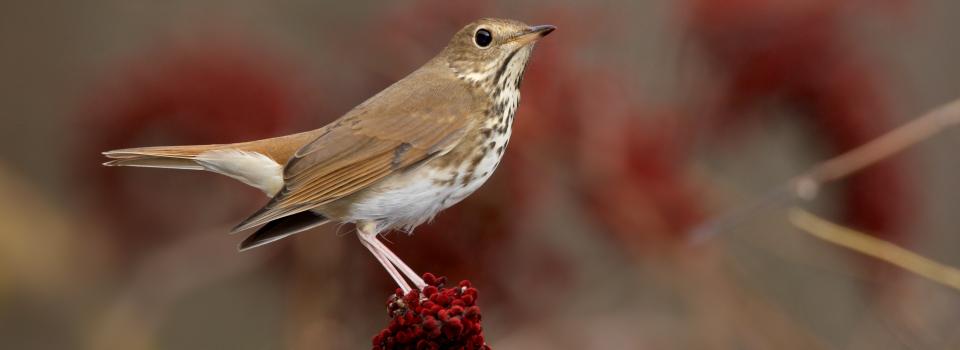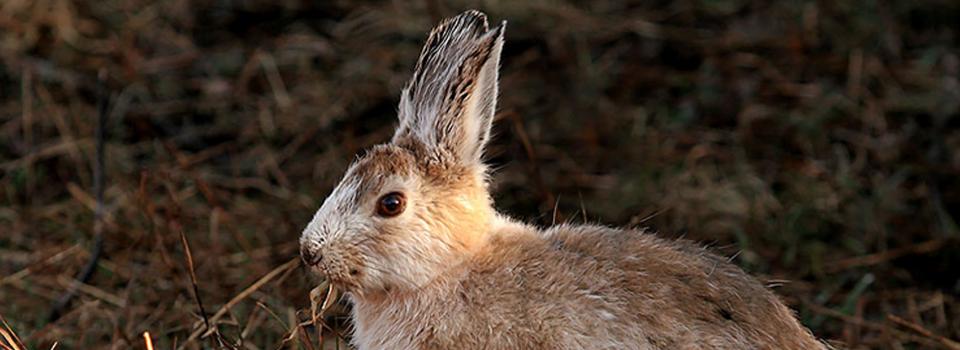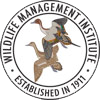Prior to announcing the call for proposals, Priority Regional Conservation Needs (RCN) Topics are developed by agency staff familiar with the development and implementation of State Wildlife Action Plans. The Northeast Association of Fish and Wildlife Agencies previously designated the following seven Priority RCN Topics.
Of the seven RCN Topic Areas, five will be active during the 2015 grant cycle. Proposals will not be accepted for topic areas that are inactive.
View/download a spreadsheet that comprehensively lists Species of Greatest Conservation Need from the northeast states' Wildlife Action Plans.
RCN Topic 1: Develop Regional Base Maps for Analyses of NE SGCN Data
Topic Area 1 is Inactive in 2015.
RCN Topic 2: Identify High Priority NE Species of Greatest Conservation Need:
-
Background: Previous work by the Northeast Partners in Reptile Conservation (NEPARC) has developed methodology useful for the identification of high priority reptile Species of Greatest Conservation Need within the Northeast. A matrix that compares and contrasts measures of regional vulnerability with measures of regional responsibility for each reptile species in the Northeast provides states with an important tool to identify highest priority Species of Greatest Conservation Need. Using the NEPARC matrix, state agencies are advancing identification of highest priority fish, mammals and birds. Desired proposals within this RCN will similarly identify highest priority species among invertebrate groups. Previous work within a similar RCN topic resulted in the development of an online invertebrate database and proposals under this topic shall coordinate wherever possible with work conducted to date.
- Potential products from the current RFP will be a list of highest priority species among invertebrate groups expressed within a classification system similar to the NEPARC-matrix model. Without the larger taxa, priority projects would focus on Lepidoptera, native pollinators, crayfish, and Odonates. Projects within the RFP may also support state agency workgroups tasked with identification of highest priority fish, birds and mammals.
- Technical Coordinator responsible for project oversight and for more information contact: John Kanter, New Hampshire Fish and Game, 3 Hazen Drive, Concord, NH 03301. Phone: 603/271-2462. Email: John.Kanter@wildlife.nh.gov
RCN Topic 3: Identify NE Species of Greatest Conservation Need Data Gaps, Design Data Collection Protocols, and Collect Data
-
Background: State Wildlife Action Plans have identified gaps in the state’s knowledge of Species of Greatest Conservation Need or guilds of Species of Greatest Conservation Need. Data gaps include documentation of current condition or trends in distribution and occurrence of Species of Greatest Conservation Need within the Northeast. In addition, data gaps may include documentation of current condition or trends in environmental factors, including distribution, occurrence, chemical properties or physical condition of terrestrial and aquatic habitat, weather, air or water.
- Potential products from the current RFP will document current condition or expected trends in distribution or occurrence of reptiles and amphibians, invertebrate and rare fish.
- Technical Coordinator responsible for project oversight and for more information contact: Rebecca K. Gwynn, Bureau of Wildlife Resources, VA Department of Game and Inland Fisheries. Phone: 804-829-6720. Email: becky.gwynn@dgif.virginia.gov
RCN Topic 4: Identification of Regional Focal Areas and Corridors for the Conservation of Species of Great Conservation Need in the Northeast
Topic Area 4 is Inactive in 2015.
RCN Topic 5: Design and Implement Conservation Strategies for NE Species of Greatest Conservation Need
-
Background: Many Northeastern states share priorities for habitat conservation to benefit Species of Greatest Conservation Need with multiple-state distributions. The states recognize that habitat protection, restoration, and management are necessary to mitigate habitat loss and degradation and to reverse negative population trends for Species of Greatest Conservation Need identified in SWAPs. We also recognize that the collective habitat requirements of many Species of Greatest Conservation Need are overlapping and subject to similar patterns of loss and degradation on the regional landscape.
- Potential products will include:
- Development and implementation of multi-partner conservation initiatives that focus on the conservation, management, and/or protection of focal habitats of Species of Greatest Conservation Need best addressed on a landscape or regional level. Examples of focal habitats and focal Species of Greatest Conservation Need for habitat conservation include: pine barrens and shrub-dominated habitats. Proposals are sought that result in or support conservation initiatives for the following list of species or for projects that address multiple Species of Greatest Conservation Need that may or may not be listed below:
- Allegheny Woodrat
- Bicknell’s Thrush
- Golden-Winged Warbler
- Least Tern
- Loggerhead Shrike
- Eastern Massasauga Rattlesnake
- Spotted Turtle
- Timber Rattlesnake
- Eastern Spadefoot Toad
- Hellbender
- Eastern Sand Darter
- Gilt Darter
- Lake Sturgeon
- Spotted Darter
- Tippecanoe Darter
- Brook Floater
- Green Floater
- Rusty Blackbird
- Cerulean Warbler
- Canada Warbler
- Wood Thrush
- For the list of species above, development of spatially explicit plans that identify and prioritize locations for management, prescribe specific conservation actions (e.g. Farm Bill), and develop Best Management Practices (BMPs) that apply across the range-wide variation in conditions of Species of Greatest Conservation Need and their habitats.
- The products of this RCN must expedite tangible results on the ground. Preference will be given to proposals that name conservation partners and describe a strategic initiative for implementation of conservation actions. Preferential treatment will be awarded to proposals submitted under this RCN that cover multiple states within a species range or the entire species range falling within the Northeast regardless of the number of states included within that range.
- Technical Coordinator responsible for project oversight and for more information contact: Dave Jenkins, Chief, Endangered and Non-game Species Program, NJ Division of Fish and Wildlife, 501 E. State Street, Mail Code: 501-03, PO Box 420, Trenton, NJ 08625-0420. Phone: 609/292-9101. Email: dave.jenkins@dep.state.nj.us
RCN Topic 6: Design and Implement Monitoring Protocols, Measures, and Indicators for NE Species of Greatest Conservation Need:
-
Background: To inform adaptive management and revision of SWAPs, states need collaborative mechanisms for implementing monitoring programs, tracking progress, and reporting performance, particularly for those Species of Greatest Conservation Need, habitats, and actions that are better served and more cost-effective to address at the regional scale. With the recent completion of the Monitoring and Performance Reporting Framework for the Northeast, states have a collective approach to documenting the status of Species of Greatest Conservation Need and their habitats. Previous work funded under this RCN includes determining the conservation status of key habitats and Species of Greatest Conservation Need in the Northeast, and developing avian indicators and measures for monitoring threats and effectiveness of conservation actions in the Northeast. New proposals under this RCN should address coordinated monitoring protocols for aquatic, estuarine, and marine Species of Greatest Conservation Need and their habitats.
- Potential products will include:
- Compiling and evaluating current monitoring protocols for regionally important aquatic, estuarine and marine Species of Greatest Conservation Need populations, and developing standardized protocols for multi-state application in the Northeast.
- Implementing monitoring programs for regionally important Species of Greatest Conservation Need populations to determine effectiveness of management actions and impacts of threats, with preference to proposals addressing nongame (rare) fish, invertebrates (especially aquatic invertebrates), amphibians, and reptiles.
- Developing new indicators and measures for monitoring regionally important aquatic and marine Species of Greatest Conservation Need populations to determine effectiveness of management actions and impacts of threats.
- Technical Coordinator responsible for project oversight and for more information contact: Dan Rosenblatt, Wildlife Diversity Section Head, New York State Department of Environmental Conservation, 625 Broadway, Albany, NY 12233-4754 Phone: 518/402-8884 Fax: 518/402-8925 Email:dlrosenb@gw.dec.state.ny.us
RCN Topic 7: Identify and Assess Threats to NE Species of Greatest Conservation Need
- Background: Some SCGN have experienced sudden and dramatic declines at the regional level. This topic seeks proposals that would address these declines by either identifying factors yet unknown and/or developing or implementing methodologies to address these factors once identified. Two examples of such recent sudden declines would be: 1) river herring (alewife and blueback herring) where several Northeast states have instituted complete harvest moratoria and restored passage at barriers to migration, yet river herring populations in those states still remain at historically low levels due to unknown factors; 2) White Nose Syndrome in bats is causing precipitous and spreading declines in multiple species of bats. In addition, as of yet unidentified or unquantified threats may cause future declines in Species of Greatest Conservation Need and this RCN topic additionally seeks proposals that would assess potential future threats. Examples of projects suitable for the RCN include wind power, Marcellus shale development, biomass harvesting, and hydropower.
- Potential products will include:
- A report that provides data to support or refute the assertion that listed factors are contributing to a sudden dramatic and widespread decline of Species of Greatest Conservation Need. Studies must go beyond individual states and investigate factors that may be impacting the species throughout the Northeast. Collaboration among investigators from different states is encouraged. It is expected that reports identifying contributing factors will include recommendations for reversing the population decline caused by the identified factor(s) and recommendations for monitoring approaches.
- A report that develops new and innovative research methodologies that are cost effective and widely applicable to support investigations that would provide reports such as those referenced in item i).
- A report on tests of research methodologies or recommendations as described above in i) and ii).
-
Technical Coordinators responsible for project oversight and for more information contact: Alison Whitlock (Tel: 413 253-8536) and Ron Essig (Tel: 413 253-8504), USFWS Division of Wildlife and Sport Fish Restoration, 300 Westgate Center Drive, Hadley, MA 01035. Fax: 413 253-8487, Email: alison_whitlock@fws.gov or ron_essig@fws.gov
- Administrative Coordinator responsible for fiscal oversight: Karen Bennett, Program Manager, DE Division of Fish and Wildlife, Natural Heritage, Endangered Species and Private Lands, 89 Kings Highway, Dover, DE 19977. Phone: 302-739-9124; Email: Karen.bennett@state.de.us













